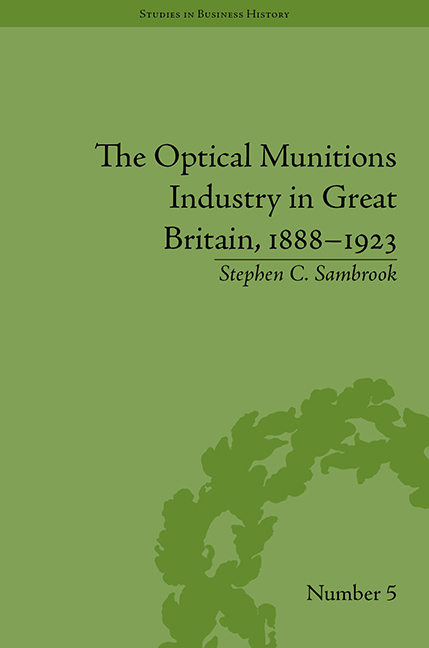Refine search
Actions for selected content:
13588 results in History of science and technology
List of Figures and Tables
-
- Book:
- The Optical Munitions Industry in Great Britain, 1888–1923
- Published by:
- Pickering & Chatto
- Published online:
- 05 December 2014, pp ix-x
-
- Chapter
- Export citation
Introduction
-
- Book:
- The Optical Munitions Industry in Great Britain, 1888–1923
- Published by:
- Pickering & Chatto
- Published online:
- 05 December 2014, pp 1-8
-
- Chapter
- Export citation
2 - The Growth in Importance from the Boer War to 1906
-
- Book:
- The Optical Munitions Industry in Great Britain, 1888–1923
- Published by:
- Pickering & Chatto
- Published online:
- 05 December 2014, pp 35-58
-
- Chapter
- Export citation
List of Technical Terms
-
- Book:
- The Optical Munitions Industry in Great Britain, 1888–1923
- Published by:
- Pickering & Chatto
- Published online:
- 05 December 2014, pp xi-xii
-
- Chapter
- Export citation
7 - Industrial Demobilization and Implosion, 1919
-
- Book:
- The Optical Munitions Industry in Great Britain, 1888–1923
- Published by:
- Pickering & Chatto
- Published online:
- 05 December 2014, pp 159-180
-
- Chapter
- Export citation
Dedication
-
- Book:
- The Decline of Jute
- Published by:
- Pickering & Chatto
- Published online:
- 05 December 2014, pp viii-viii
-
- Chapter
- Export citation
7 - The Decline of Jute and the Economic Health of Dundee
-
- Book:
- The Decline of Jute
- Published by:
- Pickering & Chatto
- Published online:
- 05 December 2014, pp 135-154
-
- Chapter
- Export citation
Works Cited
-
- Book:
- The Optical Munitions Industry in Great Britain, 1888–1923
- Published by:
- Pickering & Chatto
- Published online:
- 05 December 2014, pp 241-248
-
- Chapter
- Export citation
Acknowledgements
-
- Book:
- The Decline of Jute
- Published by:
- Pickering & Chatto
- Published online:
- 05 December 2014, pp ix-x
-
- Chapter
- Export citation
5 - Industrial Mobilization: The Ministry of Munitions and its Relationship with the Industry
-
- Book:
- The Optical Munitions Industry in Great Britain, 1888–1923
- Published by:
- Pickering & Chatto
- Published online:
- 05 December 2014, pp 107-132
-
- Chapter
- Export citation
Conclusion
-
- Book:
- The Optical Munitions Industry in Great Britain, 1888–1923
- Published by:
- Pickering & Chatto
- Published online:
- 05 December 2014, pp 205-212
-
- Chapter
- Export citation
CONTENTS
-
- Book:
- The Optical Munitions Industry in Great Britain, 1888–1923
- Published by:
- Pickering & Chatto
- Published online:
- 05 December 2014, pp v-vi
-
- Chapter
- Export citation
CONTENTS
-
- Book:
- The Decline of Jute
- Published by:
- Pickering & Chatto
- Published online:
- 05 December 2014, pp vii-vii
-
- Chapter
- Export citation

The Optical Munitions Industry in Great Britain, 1888–1923
-
- Published by:
- Pickering & Chatto
- Published online:
- 05 December 2014
-
- Book
- Export citation
3 - Expansion and Consolidation, 1907–14
-
- Book:
- The Optical Munitions Industry in Great Britain, 1888–1923
- Published by:
- Pickering & Chatto
- Published online:
- 05 December 2014, pp 59-84
-
- Chapter
- Export citation
Works Cited
-
- Book:
- The Decline of Jute
- Published by:
- Pickering & Chatto
- Published online:
- 05 December 2014, pp 201-214
-
- Chapter
- Export citation
6 - Influencing Government
-
- Book:
- The Decline of Jute
- Published by:
- Pickering & Chatto
- Published online:
- 05 December 2014, pp 119-134
-
- Chapter
- Export citation
2 - De-Globalization and Decline, 1939–99
-
- Book:
- The Decline of Jute
- Published by:
- Pickering & Chatto
- Published online:
- 05 December 2014, pp 21-34
-
- Chapter
- Export citation
1 - The Emergence of the Industry, 1888–99
-
- Book:
- The Optical Munitions Industry in Great Britain, 1888–1923
- Published by:
- Pickering & Chatto
- Published online:
- 05 December 2014, pp 9-34
-
- Chapter
- Export citation
Sounding in silence: men, machines and the changing environment of naval discipline, 1796–1815
-
- Journal:
- The British Journal for the History of Science / Volume 48 / Issue 2 / June 2015
- Published online by Cambridge University Press:
- 03 December 2014, pp. 213-232
- Print publication:
- June 2015
-
- Article
- Export citation
